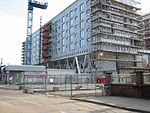Battle of Barking Creek
1939 in the United KingdomAccidents and incidents involving Royal Air Force aircraftAviation accidents and incidents in 1939Aviation accidents and incidents in EnglandCombat incidents ... and 5 more
Conflicts in 1939Friendly fire incidents of World War IIHistory of the Royal Air Force during World War IISeptember 1939 eventsWorld War II aerial operations and battles of the Western European Theatre

The Battle of Barking Creek was a friendly fire incident over England on 6 September 1939 that caused the first death of a British fighter pilot in the Second World War.
Excerpt from the Wikipedia article Battle of Barking Creek (License: CC BY-SA 3.0, Authors, Images).Battle of Barking Creek
Spur Road, London Beckton (London Borough of Newham)
Geographical coordinates (GPS) Address Nearby Places Show on map
Geographical coordinates (GPS)
| Latitude | Longitude |
|---|---|
| N 51.5282 ° | E 0.0795 ° |
Address
Cuckold Haven Nature Reserve
Spur Road
IG11 0YX London, Beckton (London Borough of Newham)
England, United Kingdom
Open on Google Maps







